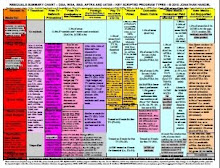The ballots for SAG’s recently approved TV/theatrical contract won’t be going out until mid to late May, a source tells me, several weeks later than the early May target that the Guild stated as recently as a week or so ago. That means that ratification, if achieved as expected, will not come until early to mid June, since balloting is expected to be a three week process. UPDATE: The ballots will go out May 19 and are due back June 9, SAG announced today.
The source, who spoke on condition of anonymity, explained that writing the pro and con statements has only just begun. That process takes a week, and then another week is allowed for rebuttal statements to be written.
(BTW, a copy of the proposed TV/theatrical agreement is available here. I’ve not yet done an analysis, but in the meantime you can read SAGWatch’s.)
Meanwhile, ballots for the commercials contract will be mailed to both SAG and AFTRA members Thursday, and due back May 21, reports Variety. It’s expected to pass easily. In contrast, the TV/theatrical contract will probably pass with a yes vote in the 60%-75% range, roughly in the neighborhood of the AFTRA deal, which achieved 62%. Only a simple majority (i.e., just over 50%) is required.
In other SAG news, Unite for Strength revealed in a Facebook email several days ago that the force majeure compromise is 33 cents on the dollar. “Force majeure” refers to arbitration claims on behalf of about 500 actors for a portion of wages lost due to the 2007-2008 Writer Guild strike. The claims amount to about $63 million, and, thus, the total settlement is about $21 million. The compromise goes into effect if the TV/theatrical agreement is ratified. Each company can opt out on a company-wide basis if they wish. SAG members will receive checks from those companies that don't opt out several weeks after the agreement is ratified, I'm told.
That settlement amount—33 cents on the dollar—is on the low side, but that was a tradeoff. SAG wants its contract to expire in mid-2011, to synch up with the WGA, AFTRA, and DGA. That’s an issue created by the ten-month delay that the hardline Membership First faction inflicted on the union; without the delay, the deals would have synched up as a matter of course. To get synchronicity at this late date, SAG had to give something up.
Remember also that the claims are under arbitration. SAG could have gotten zero cents on the dollar if the arbitration had proceeded; or it could have prevailed altogether. With that much uncertainty, a settlement in the 50% range might have been expected. That would have yielded a total of about $31 million, rather than $21 million. So, it’s a reasonable conclusion that SAG gave up about $10 million in order to get the synchronized expiration date—and prompt payment to the affected members.
The Guild also had to agree to modify the TV-related force majeure language in a way that reduces the likelihood of future force majeure claims. To put this in context, though, I’m told there has never been an industry-wide force majeure claim before. The studios obviously want to avoid seeing one again, not only to reduce their costs, but also to decrease the strength by which SAG members would support a writers strike in the future. (In other words, if actors have to bear the entire cost of their own lost wages, they may be less likely to enthusiastically support a strike by a sister union.)
Speaking of lost wages, I also have a couple of factoids on the SAG layoffs: the total number of people laid off was 36 (not 35, as previously reported), with an additional 26 unfilled positions that will remain unfilled. That’s a total reduction in force of 62 positions, and the annual savings to the Guild is $2.5 million in salaries ($4 million if bonuses and other factors are included).
Moving from lost wages to lost causes, there are developments in the lawsuit filed against SAG by the union’s own president, Alan Rosenberg, and his fellow Membership First plaintiffs 1st VP Anne-Marie-Johnson and board members Diane Ladd and Kent McCord. That suit, as you may rather have forgotten, seeks to unseat the TV/theatrical negotiating task force, as well as interim National Executive Director David White and Chief Negotiator John McGuire. That group—plus the commercials negotiating committee—is the team that managed to close two deals in as many months, while MF closed nothing at all over several years.
The lawsuit, in my opinion, hasn’t got a Popsicle’s chance in hell. After all, what judge is going to unwind a twice-ratified union leadership change? Incredibly, the lawsuit proceeds on not one but two tracks, since there are now both a trial court action and a concurrent appeal. Rosenberg’s and his co-plaintiffs’ solicitude for the members apparently includes spending their money on pointless multi-pronged litigation—understandably, since abandoning the litigation before this summer’s SAG election would be no boon to MF’s election prospects. Indeed, if MF ever wins control of the Board again, you can expect a motion to have SAG reimburse Rosenberg et al. for their no doubt considerable litigation costs.
In any case, there are developments on two fronts. In the trial court, SAG filed its Answer to the plaintiffs’ first amended complaint. A variety of defenses are asserted, including that the complaint is moot (because the SAG Board re-fired the previous NED, Doug Allen, at a meeting, after having first done so by a written assent document), interferes with the union’s right of self-governance, and is barred by the wrongful acts of Rosenberg and his co-plaintiffs (this presumably refers to the 28-hour filibuster over which Rosenberg presided in an attempt to prevent Allen from being fired).
Meanwhile, in the Court of Appeal,
What next? As the name implies, the Appellant’s Opening Brief is the first brief in the appeal. The next few weeks will see the filing of the respondent’s brief (SAG’s brief) and the reply brief (in which Rosenberg et al. get to reply to SAG’s brief). Then comes oral argument, unless the court decides to proceed based on the briefs alone (which I think the court has the right to do, but I’m not sure).
For those who find appellate work dry and lifeless (it’s all briefs and legal arguments, with no witnesses or jury), the trial court action will grind on as well, doubtless with demurrers, a motion to dismiss, motions for summary judgment, depositions, interrogatories, requests for production of documents, and all of the other costly accoutrement of modern-day litigation. Actually, that’s pretty dry and lifeless too. This could go on for months, providing amusement to everyone except SAG’s accountants. As in entertainment, so too in litigation: the show must go on.
———————
Subscribe to my blog (jhandel.com) for more about SAG, or digital media law generally. Go to the blog itself to subscribe via RSS or email. Or, follow me on Twitter, friend me on Facebook, or subscribe to my Huffington Post articles. If you work in tech, check out my new book How to Write LOIs and Term Sheets.

